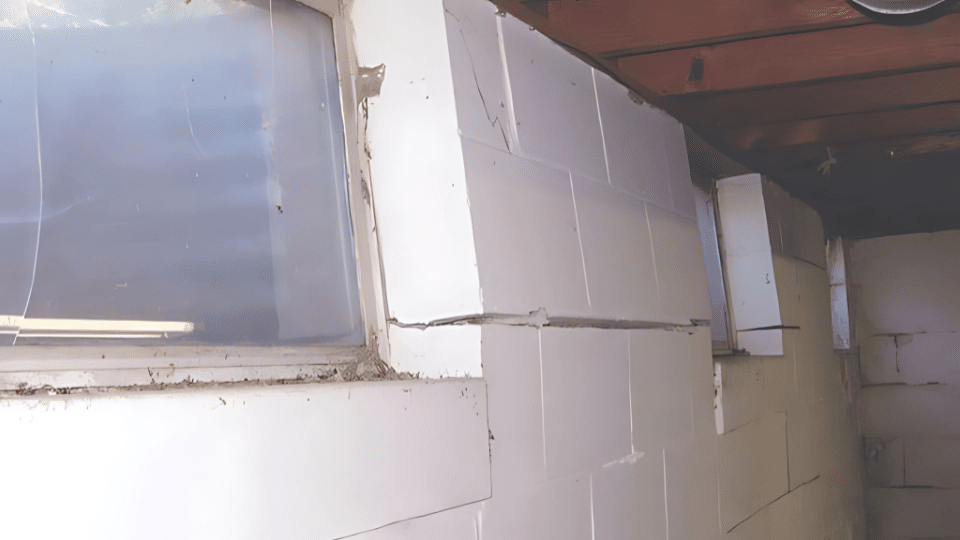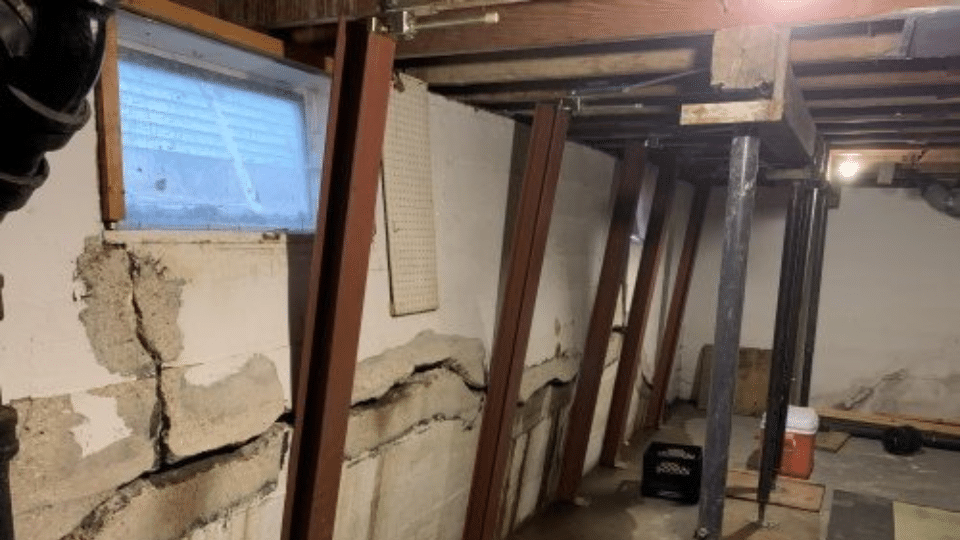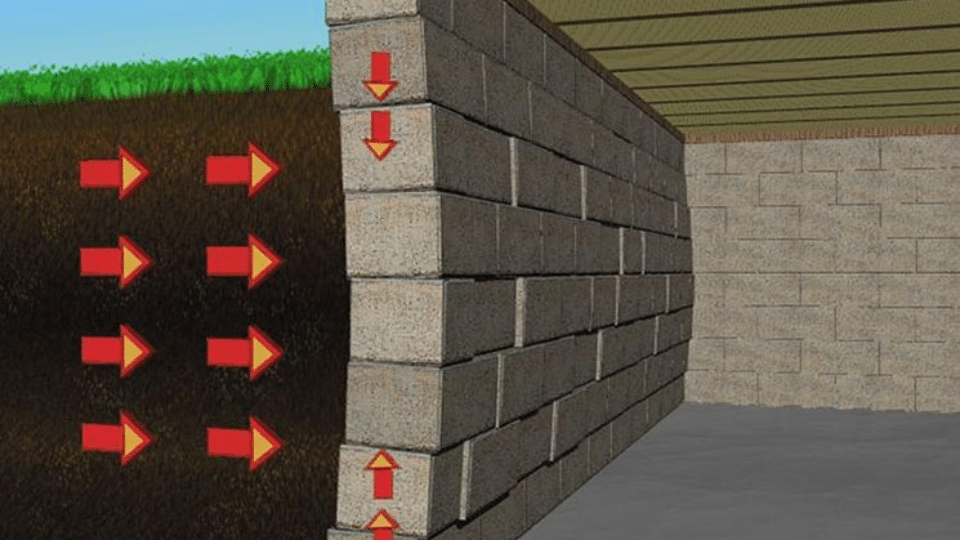Noticed cracks running across your basement walls? Doors that suddenly stick or won’t close properly? Your foundation walls might be bowing inward a serious structural problem that affects thousands of homeowners each year.
Bowing walls happen when soil pressure pushes against your foundation, causing concrete block, brick, or poured concrete walls to curve toward your basement.
Here’s the good news: bowing walls can be fixed before they cause major damage. From carbon fiber straps for minor bowing to steel anchors for severe cases, proven repair methods can stop the problem and even straighten your walls over time.
This guide covers everything you need to know about how to spot the warning signs, understand what causes walls to bow, compare repair options with real costs, and decide between DIY inspection versus professional help.
What is a Bowing Wall?
Bowing walls are foundation or basement walls that curve inward toward your home’s interior due to external pressure from soil and water.
This structural problem most commonly affects concrete block walls, brick walls, and poured concrete foundations. Walls bow inward rather than outward because the soil outside pushes against the wall.
What Causes Bowing Walls?
Soil pressure and hydrostatic pressure are the primary culprits – saturated soil becomes heavy and pushes against your foundation, while groundwater creates an additional force against the walls.
Poor drainage and water accumulation around your foundation increase this pressure as water has nowhere to go except against your basement walls.
Tree roots and expansive clay soil make the problem worse when roots grow against foundations or clay soil swells and shrinks with moisture changes.
Poor construction or weak foundation materials, like hollow concrete blocks or inadequate reinforcement, can’t handle normal soil pressure over time.
Freeze-thaw cycles and seasonal shifts cause soil to expand in winter and contract in summer, creating constant pressure changes that gradually push walls inward.
Common Signs of Bowing Walls
- Cracks in interior or exterior walls: Look for horizontal cracks running across the wall or stair-step cracks that zigzag along mortar joints – these are the first warning signs.
- Tilting at the top of the wall: The upper portion of your foundation wall leans inward, creating a noticeable slant when viewed from the side.
- Bulging or curving areas: You’ll notice sections of the wall that push outward into your basement or appear curved rather than straight.
- Water leakage or dampness: Cracks from bowing allow water to seep through, causing wet spots, mineral stains, or standing water near the wall.
- Sticking doors or windows nearby: Foundation movement causes the door frames and window frames to shift, making them jam or become difficult to open and close.
Bowing Wall Repair Methods

Here are several proven techniques to repair bowing walls, each tailored to the severity of the damage and the structural needs of your home.
1. Wall Anchors
Wall anchors use steel plates connected by rods that extend from your basement wall to stable soil outside your home. The exterior plate anchors into firm ground while the interior plate holds the wall in place.
This method works well for walls that have bowed 2-6 inches and can actually straighten the wall over time. Installation takes 1-2 days and requires digging in your yard to place the exterior anchors.
Cost: $400-$600 per anchor
2. Carbon Fiber Straps
Carbon fiber straps are high-strength strips that get bonded directly to your wall using special epoxy. The straps run vertically along the wall, preventing further bowing movement.
This method is most effective for walls with minimal bowing, typically under 2 inches. The straps are nearly invisible once installed and don’t require any excavation work. They won’t straighten existing bows but stop the problem from getting worse.
Cost: $300-$450 per strap
3. Steel I-Beams
Steel I-beams are vertical support beams installed against your basement wall and secured to the floor and ceiling joists above. These beams resist the inward pressure and can be adjusted over time to gradually straighten the wall.
This method handles severe bowing over 6 inches and walls that are still actively moving. The beams are permanent fixtures that take up some basement space but provide excellent structural support.
Cost: $350-$500 per beam
4. Helical Tiebacks
Helical tiebacks work like giant screws that get drilled deep into stable soil layers behind your foundation. Steel rods connect these helical anchors to plates on your basement wall.
This method works well when there’s limited space inside your basement or when regular wall anchors won’t hold in poor soil conditions. The installation doesn’t take up interior space and handles extreme soil pressure situations effectively.
Cost: $1,200-$1,800 per tieback
5. Steel Push Piers
Steel push piers are driven deep into the ground until they reach bedrock or very stable soil layers. Hydraulic equipment pushes these steel tubes through unstable soil to create a solid foundation support system.
This method works when your soil is too weak or shifting to support other repair methods. The piers provide the strongest possible foundation support for homes with serious soil stability problems.
Cost: $1,500-$2,000 per pier
6. Geo-Lock Wall Anchor System
The Geo-Lock system uses galvanized steel plates and adjustable rods similar to regular wall anchors but with stronger materials and better engineering. Small holes are drilled through your wall to install anchors that extend into stable soil.
The system allows for seasonal adjustments to gradually straighten your wall over several years. This method often comes with lifetime transferable warranties and handles moderate to severe bowing effectively.
Cost: $600-$800 per anchor
7. Complete Wall Replacement
Complete wall replacement involves tearing out the damaged foundation wall and building a new one. This becomes necessary when walls have bowed more than 8 inches or when the structural damage is too severe for other repair methods.
The process requires temporary support beams, excavation, and complete reconstruction. While expensive and disruptive, it’s sometimes the only safe option for severely compromised foundations.
Cost: $10,000-$25,000 for full replacement
Preventing Future Bowing Walls
- Grading and drainage improvement: Slope soil away from your foundation at least 6 inches over the first 10 feet to direct water away from your home’s base.
- Installing gutters and downspouts: Properly functioning gutters with downspouts that extend 4-6 feet from your foundation prevent water from pooling near basement walls.
- Root barriers: Install plastic or metal barriers 2-3 feet deep between large trees and your foundation to stop roots from growing against your walls.
- Regular inspection and maintenance: Check your foundation walls twice yearly for new cracks, water stains, or movement to catch problems before they become serious.
DIY vs. Professional Bowing Repair

| Factor | DIY Repair | Professional Repair |
|---|---|---|
| Risk | High. Mistakes can cause more damage. | Low. Experts know what they’re doing. |
| Code Compliance | May not follow building codes. | Meets all local code requirements. |
| Cost | Cheaper at first, costly if done wrong. | More expensive, but usually done right. |
| Tools | Must buy or rent tools yourself. | Pros bring all needed tools. |
| Reliability | May not last long. | Built to last, often with warranty. |
| Time | Takes longer, especially for beginners. | Done faster by skilled workers. |
| Home Value | May hurt resale if not done right. | Helps resale with proof of quality work. |
| Contractor Search | Not needed. | Check reviews, license, and warranty. |
Conclusion
Bow walls are a serious foundation issue that won’t fix themselves. The horizontal cracks, tilting, and bulging we’ve covered are clear warning signs that demand immediate attention.
From minor bowing treatable with carbon fiber straps to severe cases requiring steel anchors or complete replacement, you now have multiple repair options to choose from.
Don’t wait until small cracks become major structural failures. Early intervention with methods like wall anchors ($400-$600 each) or PowerBrace systems can save you thousands compared to full wall replacement ($10,000-$25,000). Regular inspections and proper drainage can prevent future problems entirely.
Ready to protect your investment? Schedule a free foundation inspection today and get expert advice on the best repair method for your specific situation.
Frequently Asked Questions
When to Be Concerned About a Bowing Wall?
You should be concerned when your wall has any visible inward curve, horizontal cracks longer than 2 feet, or bowing that measures more than 1 inch from straight.
What Does a Bowing Wall Mean?
A bowing wall means your foundation is under excessive soil and water pressure, causing structural weakness that can lead to wall collapse if left untreated.
How Do you Fix Bowing Walls?
Bowing walls are fixed using wall anchors, carbon fiber straps, steel I-beams, or helical tiebacks depending on the severity of the bow and your specific situation.
How Much Bowing in a Wall Is Acceptable?
Any bowing over 1 inch is unacceptable and requires immediate professional evaluation – even minor bowing under 1 inch should be monitored closely for changes.








